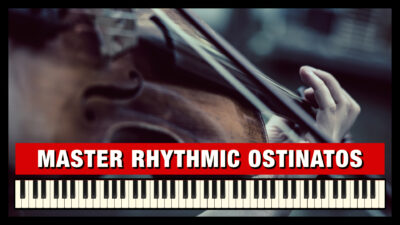 The Definition of an Ostinato
The Definition of an Ostinato
Let’s start by defining what an ostinato is. Here is the Wikipedia definition: “In music, an ostinato is a motif or phrase that persistently repeats in the same musical voice, frequently in the same pitch.”
Learn How to Create Powerful Ostinatos here.
Alright, but let’s make this more clear for you. Ostinato is the Italian word for stubborn, persistent or obstinate. Knowing this will help you get a better sense of the true meaning of an ostinato. A rhythmic note pattern that feels repetitive.
Arpeggios vs Riffs vs Ostinatos
Now, you can play many things in music in a repetitive fashion. Let’s compare 3 examples: Arpeggios, Riffs and Ostinatos.
The difference between each is not a strict line, but rather a gradual one. Like the colors of a rainbow. However, I have a couple of aspects on each of these examples, that I use to define them musically:
1. Arpeggios = Flow
The focus is on running and jumping around on the chord notes. Even though arpeggios can feel repetitive, they are rather focused on “flow”, compared to a driving pulse.
2. Riffs = Focus
The focus of riffs is to create a musical motif that people remember. No one really remembers a driving ostinato, or flowing arpeggio. But a riff is played to be in focus.
Riffs often have more variation in the performance techniques, as well as added expression in the notes. Like adding a vibrato or bend on some notes, gliding between notes, using various note lengths in a musical fashion rather than strictly rhythmic, and so on.
3. Ostinato = Drive
The focus of ostinatos is on rhythm and pulse. And even though you can switch notes a lot to follow chords and harmonies, the main purpose of an ostinato is to add that persistent drive that adds energy into your music.
Monophonic vs Polyphonic Ostinatos
Strictly speaking I believe a true ostinato should be monophonic, meaning one voice played at a time. However, practically speaking I believe you can think of rhythmic harmonies as ostinatos too.
If you play them in the same repetitive fashion, and if the end goal and purpose of those parts is the same. Which again is to add rhythmic pulse and drive into your composition.
This means that you can use block chords and harmonies on for example staccato strings as ostinatos. Or perhaps chugging powerchords on an electric guitar.
Always Dance the same Dance
However, whether you use monophonic or polyphonic ostinatos, you should always be aware of the main rhythms, harmonies and melodies in the rest of your composition. Because all elements of music should dance the same dance together.
Congratulations!
You have now learned what ostinatos are, the focus and purpose of them, and the difference between arpeggios, riffs and ostinatos.
Learn How to Create Great Ostinatos – Click Here

